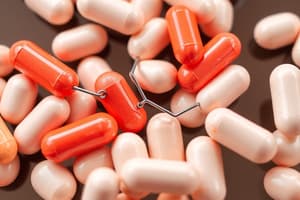Podcast
Questions and Answers
Which mechanism of action is shared by both penicillins and cephalosporins?
Which mechanism of action is shared by both penicillins and cephalosporins?
- Inhibition of glycopeptide formation.
- Interference with peptidoglycan synthesis. (correct)
- Direct destabilization of bacterial DNA.
- Inhibition of the 30S ribosomal subunit.
A patient reports a history of a mild rash after taking penicillin. Which course of action is MOST appropriate when considering a cephalosporin for surgical prophylaxis?
A patient reports a history of a mild rash after taking penicillin. Which course of action is MOST appropriate when considering a cephalosporin for surgical prophylaxis?
- Administer a test dose of penicillin to confirm the allergy.
- Administer a later-generation cephalosporin without further testing.
- Administer a later-generation cephalosporin after a test dose. (correct)
- Avoid all beta-lactam antibiotics due to high risk of cross-reactivity.
Why is cefazolin often administered with metronidazole for colorectal surgery prophylaxis?
Why is cefazolin often administered with metronidazole for colorectal surgery prophylaxis?
- Metronidazole provides coverage against anaerobic bacteria. (correct)
- Metronidazole enhances the gram-positive coverage of cefazolin.
- Metronidazole provides synergistic activity against S. aureus.
- Metronidazole is added to reduce the risk of nephrotoxicity.
Following the administration of cefazolin, a patient develops nausea, vomiting, and phlebitis at the IV site. Which adverse effect of cefazolin is LEAST likely in this scenario?
Following the administration of cefazolin, a patient develops nausea, vomiting, and phlebitis at the IV site. Which adverse effect of cefazolin is LEAST likely in this scenario?
What factor MOST significantly reduces the risk of cross-reactivity between penicillins and cephalosporins?
What factor MOST significantly reduces the risk of cross-reactivity between penicillins and cephalosporins?
What adjustment should be made to the gentamicin dose when the antibiotic is being used for surgical prophylaxis in a patient with renal failure?
What adjustment should be made to the gentamicin dose when the antibiotic is being used for surgical prophylaxis in a patient with renal failure?
Why should gentamicin be infused slowly over at least 30-120 minutes when administered IV for surgical prophylaxis?
Why should gentamicin be infused slowly over at least 30-120 minutes when administered IV for surgical prophylaxis?
A patient receiving gentamicin develops acute tubular necrosis. What adverse effect of gentamicin is the patient experiencing?
A patient receiving gentamicin develops acute tubular necrosis. What adverse effect of gentamicin is the patient experiencing?
Which antibiotic is metabolized by the liver and has a long half-life, requiring consideration of potential drug interactions?
Which antibiotic is metabolized by the liver and has a long half-life, requiring consideration of potential drug interactions?
A patient develops prolonged repolarization and QTc prolongation after antibiotic administration. Which antibiotic is MOST likely contributing to this adverse effect?
A patient develops prolonged repolarization and QTc prolongation after antibiotic administration. Which antibiotic is MOST likely contributing to this adverse effect?
Why is clindamycin a good choice for treating intra-abdominal infections?
Why is clindamycin a good choice for treating intra-abdominal infections?
A patient develops diarrhea, abdominal pain, and is subsequently diagnosed with C. difficile colitis after treatment with an antibiotic. Which antibiotic is MOST likely the cause?
A patient develops diarrhea, abdominal pain, and is subsequently diagnosed with C. difficile colitis after treatment with an antibiotic. Which antibiotic is MOST likely the cause?
After administering clindamycin, the anesthetist notices the patient has prolonged neuromuscular blockade. How does clindamycin contribute to this effect?
After administering clindamycin, the anesthetist notices the patient has prolonged neuromuscular blockade. How does clindamycin contribute to this effect?
A patient receiving vancomycin develops redness, itching, and hypotension. What is the MOST likely cause of these symptoms?
A patient receiving vancomycin develops redness, itching, and hypotension. What is the MOST likely cause of these symptoms?
What is the mechanism by which vancomycin inhibits bacterial cell wall synthesis?
What is the mechanism by which vancomycin inhibits bacterial cell wall synthesis?
For which surgical procedures is metronidazole often recommended for surgical prophylaxis?
For which surgical procedures is metronidazole often recommended for surgical prophylaxis?
What is the mechanism of action of metronidazole?
What is the mechanism of action of metronidazole?
Why should patients taking oral metronidazole avoid alcohol?
Why should patients taking oral metronidazole avoid alcohol?
Which adverse effect is associated with fluoroquinolones, particularly in the musculoskeletal system?
Which adverse effect is associated with fluoroquinolones, particularly in the musculoskeletal system?
What is the primary reason fluoroquinolones are typically avoided in pediatric patients?
What is the primary reason fluoroquinolones are typically avoided in pediatric patients?
In a pediatric patient weighing less than 40 kg, how is the dose of cefazolin typically determined for surgical prophylaxis?
In a pediatric patient weighing less than 40 kg, how is the dose of cefazolin typically determined for surgical prophylaxis?
For which surgical location does chlorhexidine require extra caution to prevent corneal toxicity?
For which surgical location does chlorhexidine require extra caution to prevent corneal toxicity?
Chlorhexidine is more effective at reducing skin flora due to which characteristic?
Chlorhexidine is more effective at reducing skin flora due to which characteristic?
Which antiseptic has the lowest risk of corneal toxicity?
Which antiseptic has the lowest risk of corneal toxicity?
What is the benefit of wiping off any antiseptic used for surgical prep at the end of the procedure?
What is the benefit of wiping off any antiseptic used for surgical prep at the end of the procedure?
Which of the following statements accurately describes the mechanism of action of beta-lactam antibiotics?
Which of the following statements accurately describes the mechanism of action of beta-lactam antibiotics?
What is a key mechanism by which bacteria develop resistance to beta-lactam antibiotics?
What is a key mechanism by which bacteria develop resistance to beta-lactam antibiotics?
Which factor is crucial to consider when assessing a patient for beta-lactam hypersensitivity and determining the potential for cross-reactivity?
Which factor is crucial to consider when assessing a patient for beta-lactam hypersensitivity and determining the potential for cross-reactivity?
Which of the following statements is MOST accurate regarding the post-antibiotic effect (PAE) of aminoglycosides?
Which of the following statements is MOST accurate regarding the post-antibiotic effect (PAE) of aminoglycosides?
What is the primary mechanism by which macrolides exert their antimicrobial effect?
What is the primary mechanism by which macrolides exert their antimicrobial effect?
What specific concern is associated with the IV administration of macrolides, such as erythromycin or azithromycin?
What specific concern is associated with the IV administration of macrolides, such as erythromycin or azithromycin?
Which statement accurately describes the metabolism and elimination of clindamycin (Cleocin) in the body?
Which statement accurately describes the metabolism and elimination of clindamycin (Cleocin) in the body?
What is the key mechanism by which vancomycin inhibits bacterial cell wall synthesis, leading to its bactericidal effect?
What is the key mechanism by which vancomycin inhibits bacterial cell wall synthesis, leading to its bactericidal effect?
What is the MAIN mechanism of action of fluoroquinolones?
What is the MAIN mechanism of action of fluoroquinolones?
Flashcards
Beta-Lactams
Beta-Lactams
A class of antimicrobials including penicillins and cephalosporins, characterized by a beta-lactam ring.
Beta-Lactam Mechanism
Beta-Lactam Mechanism
They interfere with peptidoglycan synthesis, inhibit penicillin-binding proteins, and disrupt murein hydrolase inhibitors, leading to cell wall destruction.
Beta-Lactam Resistance
Beta-Lactam Resistance
Bacterial resistance to beta-lactams arises from factors such as beta-lactamase production, altered penicillin-binding proteins, and efflux pumps.
Penicillins
Penicillins
Signup and view all the flashcards
Beta-Lactamase Inhibitors
Beta-Lactamase Inhibitors
Signup and view all the flashcards
Cephalosporins Mechanism
Cephalosporins Mechanism
Signup and view all the flashcards
Cefazolin
Cefazolin
Signup and view all the flashcards
Beta-Lactam Cross-Reactivity
Beta-Lactam Cross-Reactivity
Signup and view all the flashcards
Aminoglycosides Mechanism
Aminoglycosides Mechanism
Signup and view all the flashcards
Aminoglycosides
Aminoglycosides
Signup and view all the flashcards
Aminoglycosides spectrum
Aminoglycosides spectrum
Signup and view all the flashcards
Aminoglycosides Adverse Effects
Aminoglycosides Adverse Effects
Signup and view all the flashcards
Macrolides mechanism
Macrolides mechanism
Signup and view all the flashcards
Macrolides
Macrolides
Signup and view all the flashcards
Clindamycin Mechanism
Clindamycin Mechanism
Signup and view all the flashcards
Clindamycin Distribution
Clindamycin Distribution
Signup and view all the flashcards
Clindamycin Adverse Effects
Clindamycin Adverse Effects
Signup and view all the flashcards
Vancomycin Mechanism
Vancomycin Mechanism
Signup and view all the flashcards
Red Man Syndrome
Red Man Syndrome
Signup and view all the flashcards
Metronidazole Mechanism
Metronidazole Mechanism
Signup and view all the flashcards
Metronidazole Spectrum
Metronidazole Spectrum
Signup and view all the flashcards
Fluoroquinolones Mechanism
Fluoroquinolones Mechanism
Signup and view all the flashcards
Fluoroquinolones
Fluoroquinolones
Signup and view all the flashcards
Fluoroquinolones Adverse Effects
Fluoroquinolones Adverse Effects
Signup and view all the flashcards
Pediatric Antimicrobial Prophylaxis
Pediatric Antimicrobial Prophylaxis
Signup and view all the flashcards
Pediatric Fluoroquinolone Use
Pediatric Fluoroquinolone Use
Signup and view all the flashcards
Chlorhexidine
Chlorhexidine
Signup and view all the flashcards
Chlorhexidine Risks
Chlorhexidine Risks
Signup and view all the flashcards
Povidone Iodine
Povidone Iodine
Signup and view all the flashcards
Corneal Toxicity
Corneal Toxicity
Signup and view all the flashcards
Post-prep wiping
Post-prep wiping
Signup and view all the flashcards
Study Notes
Antimicrobials
Beta-Lactams
- Includes penicillins and cephalosporins
- Contains a beta-lactam ring
- Interferes with peptidoglycan synthesis
- Inhibits penicillin-binding proteins
- Interferes with murein hydrolase inhibitor
- Leads to cell wall destruction
- Bactericidal/bacteriolytic
- Bacterial resistance occurs through:
- Inability to access the site
- Production of beta-lactamases
- Altered penicillin-binding proteins
- Efflux pumps
- Decreased porins in gram-negative bacteria
Penicillins
- Penicillin G originally
- Anti-staphylococcal penicillins: nafcillin, oxacillin
- Broad-spectrum penicillins: ampicillin, piperacillin
- Uses include prophylaxis for dental, oral, GI, GU, and vaginal surgeries
- Rapidly excreted renally
- Ampicillin, piperacillin require dose adjustment in renal disease
- Beta-lactamase inhibitors: clavulanic acid
- Combined with penicillins to protect from bacterial breakdown
- Penicillin allergy is the most common drug allergy
- Differentiate between severe reactions (anaphylaxis, Stevens-Johnson Syndrome) and mild intolerances
- Serious delayed reactions warrant avoidance of other beta-lactams
- Mild reactions may allow for later-generation cephalosporins or penicillin after test dose
- Family history of penicillin allergy is not a genetic trait
- Cross-sensitivity to other beta-lactams is possible
Cephalosporins
- Interferes with peptidoglycan synthesis by binding to penicillin-binding proteins (transpeptidases)
- Prevents cross-linking
- Surgical prophylaxis, meningitis
- Therapeutic levels in various body fluids
- Administered PO, IM, or IV
- Dose adjustments needed in renal failure
- Resistance can occur due to the production of cephalosporinases
- Cefazolin (Ancef, Kefzol) is the drug of choice for surgical prophylaxis
- Effective against gram-positive cocci (e.g., S. aureus) and penicillinase-producing staphylococci
- Has relative resistance against gram-negative organisms
- Higher blood levels than other first-generation cephalosporins
- Crosses the placenta, poor penetration of the blood-brain barrier
- Given with metronidazole for colorectal surgery
- Surgical prophylaxis dosing:
- 2 grams IV for patients under 120 kg
- 3 grams IV for those 120 kg and above
- Some facilities may still use 1 gram for patients under 70 kg
- Administer within 60 minutes of incision
- Reconstituted with 10-100 mL NS, D5W, or SW
- Given over 3-5 minutes
- Repeated every 4 hours until closure
- Adjustments for renal failure based on creatinine clearance
- Adverse effects:
- N/V
- Hypersensitivity
- Phlebitis
- Transient elevation of hepatic enzymes
- Stevens-Johnson syndrome
- Superinfection
- Seizures (especially in seizure disorders)
- Increased effects of anticoagulants
- Increased risk of Lasix-induced nephrotoxicity
- Pregnancy category B
- Other generations of cephalosporins (e.g., cefoxitin, ceftriaxone, cefepime)
Beta-Lactam Cross-Reactivity
- Penicillins and cephalosporins share a beta-lactam ring, cross-reactivity is rare (1-2% risk)
- Side chain structure determines cross-reactivity
- True allergy to penicillin does not automatically preclude use of all cephalosporins
- Assess for immediate reactions (laryngeal edema, bronchospasm, cardiovascular collapse) and delayed reactions (maculopapular rash, fever)
- Cefazolin is the most likely cephalosporin to cause anaphylaxis
Aminoglycosides
- Examples: gentamicin, tobramycin, and amikacin
- Binds to the 30s ribosomal subunit
- Interferes with protein synthesis during mRNA translation
- Bactericidal against aerobic gram-negative bacilli
- Effective with other agents for gram-positive infections
- Resistance occurs through:
- Impaired cell penetration
- Inactivation by microbial enzymes
- Low affinity for bacterial ribosomes
- Poor lipid solubility and bioavailability w/ oral dosing
- Elimination is prolonged in renal failure, post-antibiotic effect
- Gentamicin used off-label for surgical prophylaxis, particularly in urology cases
- Dose: 1.5-5 mg/kg IV within 60 minutes of procedure start
- Infused over at least 30-120 minutes using an IV pump
- Dose decreased in renal failure
- Can increase the effects of neuromuscular blockers
- Increased toxicity risk with loop diuretics
- Adverse effects:
- Ototoxicity (vestibular and auditory dysfunction)
- Nephrotoxicity (acute tubular necrosis)
- Skeletal muscle weakness via inhibiting acetylcholine release and decreasing postsynaptic sensitivity
- Hypersensitivity reactions are uncommon
Macrolides
- Examples: erythromycin, azithromycin, and clarithromycin
- Binds to the 50s ribosomal subunit
- Inhibits protein synthesis
- Broad-spectrum, usually bacteriostatic, bactericidal at high doses
- Effective against gram-positive and some gram-negative bacteria
- Used for respiratory tract and severe infections (IV)
- IV administration carries risks of thrombophlebitis, nausea, and tinnitus
- Erythromycin is extensively metabolized by the liver, azithromycin has a long half-life
- Adverse effects:
- Prolonged repolarization and QTc prolongation (cardiac)
- Gastrointestinal issues
- Increased effect of anticoagulants
- CYP450 enzyme inhibition (especially erythromycin)
Clindamycin (Cleocin)
- A lincosamide antibiotic
- Binds to the 50s ribosomal subunit
- Inhibits peptide chain synthesis
- Used for surgical prophylaxis
- Effective against anaerobes, streptococci, and staphylococci
- Oral, pharyngeal, lung, respiratory, and intra-abdominal infections
- Good oral bioavailability
- Distributes well into bone and urine
- Crosses the placenta, minimal CSF levels
- Post-antibiotic effect for some bacteria
- Metabolized by the liver and excreted by the kidneys
- No typical dose adjustment needed for hepatic or renal disease
- Surgical prophylaxis dosing:
- Adults: 900 mg IV infused over 10-60 minutes (ideally 30 minutes) within 60 minutes of incision
- Redosed every 6 hours until closure
- Incompatible with barbiturates, calcium gluconate, and many other antibiotics
- Adverse effects:
- Neuromuscular blockade (pre- and post-junctional effects)
- Gastrointestinal issues (diarrhea, C. difficile colitis, abdominal pain, N/V)
- Thrombophlebitis
- Allergic reactions (rash, Stevens-Johnson syndrome, eosinophilia)
- Neuromuscular blockade due to direct effects at the neuromuscular junction, not CYP450 inhibition
Vancomycin (Vancocin)
- Binds tightly to the cell wall precursor
- Blocks glycopeptide formation and inhibits cell wall synthesis
- Bactericidal and highly effective against gram-positive bacteria
- Used for MRSA, C. difficile, penicillin-resistant endocarditis, and sepsis
- Used off-label for surgical prophylaxis in penicillin or cephalosporin allergy
- Distributes widely in tissues not CSF
- Serum trough levels, renal function, and CBC may be monitored with long-term use
- Primarily excreted unchanged by the kidneys
- Clearance reduced in the elderly
- Surgical prophylactic dose: 10-15 mg/kg IV, not exceeding 2 grams
- Started within 60-120 minutes of incision
- Infused over at least 60 minutes
- Redosing typically not done sooner than 12 hours later
- Adverse effects:
- Red Man Syndrome (rate-related histamine release)
- Redness, itching, hypotension, dyspnea
- Treated by halting infusion
- Giving histamine blockers (Benadryl and famotidine) before restarting at half the rate
- True allergic reactions (requiring epinephrine and discontinuation)
- Hypoxemia
- Nephrotoxicity (increased risk with other nephrotoxic drugs)
- Ototoxicity (rare, similar symptoms to aminoglycosides)
- Prolonged use can lead to superinfection
- Red Man Syndrome (rate-related histamine release)
- IV form generally not recommended in pregnancy due to potential risks of fetal malformation
Metronidazole (Flagyl)
- Diffuses into the bacterial cell
- Metabolized into cytotoxic particles that break down and destabilize the cell's DNA
- Bactericidal and highly effective against anaerobic bacteria, gram-negative bacteria, protozoa, Clostridium, and H. pylori
- Recommended for surgical prophylaxis in colorectal, urologic, and head/neck cases
- Given with Ancef to cover gram-positive skin flora
- Surgical prophylaxis dose: 500 to 1000 mg PO or IV within 60 minutes of incision
- Bacterial resistance is rare
- Adverse effects:
- Headache, nausea, vomiting, dry mouth, metallic taste, infection, neurologic disturbances, and neuropathy
- Patients taking oral flagyl should avoid alcohol due to potential intolerance
Fluoroquinolones
- Examples: ciprofloxacin, moxifloxacin, and levofloxacin
- Inhibits DNA synthesis and promotes DNA breakage
- Bactericidal and broad-spectrum
- Effective against enteric organisms, gram-negative and gram-positive bacteria, anaerobes, mycobacteria, and respiratory/GI/GU pathogens
- Ciprofloxacin (Cipro) may be used off-label for surgical prophylaxis
- Dose: 400 mg IV within 2 hours of incision
- Administered slowly over 60+ minutes through a large bore IV
- Adverse effects:
- Bacterial resistance
- Gastrointestinal upset
- CNS disturbances
- Neuropathy
- Hepatotoxicity (elevated liver enzymes)
- Musculoskeletal issues (tendinopathy, tendon rupture, muscle weakness)
- QTc prolongation
Pediatrics
- Antimicrobial selection for prophylaxis in pediatrics generally mirrors adult guidelines
- Cephalosporins are the agents of choice
- Vancomycin used for beta-lactam allergy
- Fluoroquinolones avoided due to toxicity risks
- Dosing is often weight-based for children less than 40 kg
- UCSF typical doses:
- Cefazolin 25 mg/kg every 4 hours
- Clindamycin 10 mg/kg
- Flagyl 7.5 mg/kg
- Vancomycin 10-15 mg/kg (same as adults)
- Adult doses should not be exceeded in pediatric patients based on weight
Topical Antiseptics
Chlorhexidine (ChloraPrep, Betasept)
- Common surgical wash or scrub, typically at a 2% concentration
- More effective at reducing skin flora than povidone-iodine
- Persistent effect and is poorly absorbed
- Application should be liberal for 2+ minutes and repeated
- Disrupts bacterial cell membranes, effective against gram-positive and gram-negative bacteria
- Risk of corneal toxicity (chemical burn)
- Potential neurotoxicity if it enters the neuraxial space (allow to dry thoroughly before needle insertion)
- For facial/head/neck surgery, eyes must be protected with occlusive dressings (e.g., Tegaderm) or eye shields with lubricant
Povidone-Iodine (Betadine, DuraPrep)
- Provides immediate bactericidal action
- A 10% solution can decrease skin flora by over 90% and lasts for 6-8 hours
- Application involves scrubbing for about 5 minutes
- Lower risk of corneal toxicity compared to chlorhexidine, but is still possible
Iodine
- Rapid-acting antiseptic that kills bacteria, viruses, and spores, often administered as a tincture
- Toxicity risk increases with concentration
- Carries a corneal toxicity risk and can rarely cause allergic skin reactions
- After prepping with any antiseptic, it is generally wiped off as much as possible at the end of the case
Studying That Suits You
Use AI to generate personalized quizzes and flashcards to suit your learning preferences.




